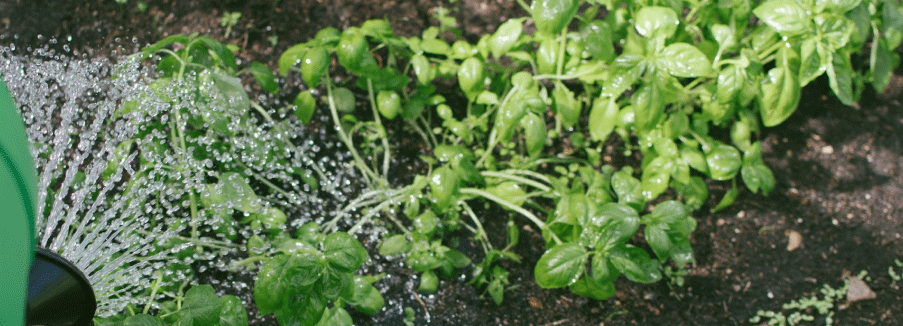How to Start an Herb Garden with the Entire Family!

Growing an herb garden is the perfect activity to take on as the weather gets warmer and you spend more time outside… Even if it’s only in the comfort of your backyard for the time being! Herbs tend to be much easier to grow than many houseplants, plus you can eat them. Need more convincing?
Knowing where your food is grown and how it is cultivated isn’t only empowering, but it’s also ecological and protective—over your body, the world, and your wallet. That’s why we believe that growing your own produce is a wonderful thing! Your body will thank you for feeding it food that’s rich in nutrients and lacking in toxins. The world will thank you for keeping its air pure and its soil well nurtured. And your wallet will thank you as you spend less money buying produce and more time watching your plants appreciate.
We understand that the thought of growing your own lettuce, squash, or cauliflower seems a little daunting. Especially if you have limited space and limited time. If this is you, starting an herb garden is the ideal first step towards developing a green thumb without becoming a full-on horticulturist (an “expert in garden cultivation,” that is…).
Herbs are smaller, require less maintenance, and are just as yummy and exciting to grow as larger vegetables. Follow these next few steps and you’ll be growing your own cilantro, dill and parsley in no time!

CHOOSE YOUR LOCATION
Herbs are fairly easy (and fun) to grow with just a little sunshine, soil, and water. Herbs can be grown in individual pots, together in a container or as an herb garden. All three methods are effective but we’ve found that plants always prefer to be in the ground where their roots can spread as far and wide as they’d like. They also tend to grow much larger when they’re planted in the ground. When placed in pots, they can become stunted and not grow to their fullest potential.
The largest factor to consider before growing herbs is where you are going to grow them. Just like real estate, location is everything! Most herbs prefer full sun exposure… as long as your regular summer temperatures don’t rise above 90 degrees. If you have very warm summers, you may want to consider planting your herbs under a tree or in an area that gets great sunlight in the mornings and shade in the afternoons. Herbs can still grow with less sunshine; they will just not grow as fast.
Once you’ve found your “spot,” it’s time to get planting! For planting herbs, you need about 1 to 5 feet in diameter per plant, depending on the herb. Guidelines are typically included when you purchase your plants, though here are our recommendations:
Rosemary, Sage, Mints, Lavender, Oregano – 3-4 feet
Aloe Vera, Basils, Chamomile, Lemongrass, Savory, Thyme, Tarragon – 2 feet
Cilantro, Chives, Dill, Fennel, Parsley – 1 foot
PREPARE THE SOIL
It is important to prepare the soil before you plant your herbs. Using a garden fork to loosen up the soil will create space for plant roots to reach down into the soil and will allow water to drain and reach those deeper roots. This step in the process does not take very long and it is essential in order to grow healthy, happy and lasting herbs!
Pro Tip: If you have compost on hand, adding about an inch on top of your soil and mixing it in helps prevent drainage problems and adds more organic nutrients to the herb garden.

PLANT THE HERBS
Your final step in becoming an herb guru is to plant the herbs in your rich soil. Once they’re planted, you’ll want to promptly add water and begin watching the magic! When you start to see the soil getting dry, do not hesitate to grab your watering can. A “rule of thumb” we like to use is as soon as the soil about a couple of inches below the surface is dry, it’s time to water your garden.
Frequency of watering can also depend on soil type and weather. With this said, most herbs need about one-inch of water per week to remain healthy. You can also add more compost to the soil every once in a while, to help the plants retain moisture and receive additional nutrients.
Keep in mind that we typically like to over water our plants. Too much water can be just as harmful as not enough and can lead to disease or difficult growing conditions for your herbs. We recommend using our “rule of thumb” at first, and eventually you will learn what is best for your particular garden.

HARVEST THE HERBS (AKA IT’S TIME TO EAT!)
When you’re ready to harvest your herbs to make homemade salsa, basil pesto, or that one tarragon chicken recipe you’ve been dying to try, simply cut off 1/3 of the branches once the plant reaches about 6-8 inches tall and there you have it, you’re growing your own herbs! Cutting as close as you can to a leaf intersection will also make your plants regrow very quickly.
• • •
This doesn’t sound so bad, right?! And if you have a family, this is the perfect activity to do alongside your kiddos. Gardening teaches kids that the fruit (literally) of their labor isn’t always immediate, but is definitely worth the wait. It also teaches them that chores can be fun, it expands their palettes, and it gets them outside interacting with the beautiful world in which they live.
There’s nothing like watching your kids run to the backyard every morning to check on their veggies. What a concept, right? You’ll have your kids trying sage and parsley before you know it!
If you decide to take a crack at your own herb garden, let us know in the comments so we can be excited about what you’re harvesting! Happy planting. 😊

